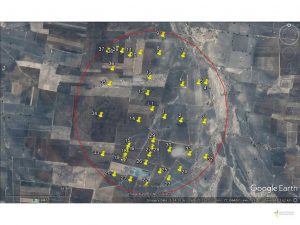Ones upon a time, the western part of Vidarbha region of Maharashtra was known for its rich savannah grassland ecosystems. During colonial times Britain’s increasing demand for cotton was not met due to war situation in cotton growing areas of Egypt. Thus, huge belts of Vidarbha grasslands were converted into cotton farms (Laxman satya 2004)1. In 2001 Samvedana initiated a socio-environmental study involving Phasepardhi tribe of traditional hunters. It is the only tribe with traditional knowledge of savannah grasslands. During this study we came across an endangered species of bird Lesser florican (Sypheotides indicus). The presence of florican and its breeding was also part of traditional knowledge of the Phasepardhi tribe. In-situ conservation of traditional grass species was initiated by the tribe as this was the source of fodder for their livestock.
Samvedana continued its work through Maharashtra Gene Bank Program with Rajiv Gandhi Science and Technology Commission and Indian Institute of Science Education and Research (IISER Pune) in 2015. Community conservation areas have been developed and managed through Biodiversity Management Committees (BMC) established under biodiversity act 2002. Scientific studies of grassland biodiversity, quantification of fodder availability and territory of florican has been carried out during the project. Training programs on scientific methods of biological resource mapping were conducted with the community youths. Youths implemented this knowledge by classifying grass species, doing herbarium, using GPS devises and plotting quadrats in community conserved areas. Projection of specie-wise yield of fodder production was calculated. Selection of areas for grass species conservation and fodder development has been planned through these studies. This is the only effort to conserve and manage grassland biodiversity resources using scientific methods in the project area.
In another important study, which is being conducted with the participation of knowledgeable individuals belonging to the Phasepardhi tribe is mapping of territory of Lesser florican. Though it is proved that the small population of florican is present in the project area, its habitat preferences and adaptation is not known to scientific community. The study is planned to know these grassroot parameters with the active help of knowledgeable individuals from the tribe. The GPS locations of recent sightings of florican were documented. Each site is marked with round of 2 square kilometres (as it’s a projected territory of floricans) and further divided into each land piece. Details of each land piece is documented i.e. land use pattern, biodiversity mapping and tenure.

Image1.
Outcome of this study will help not only to understand the present habitat preferences of the bird but also identify the possible areas where it could be sighted. The proportion of agricultural land and grassland is also measured. Associations of bird with certain species or landscapes could also be projected. In addition to this the study gives an opportunity to the tribe to use their traditional knowledge for new constructive areas other than hunting. Such initiatives help in the changing the social identity and stigmatisation of the Phasepardhi tribe as wildlife poachers.
These participatory efforts open up new avenues in the study of grassland biodiversity in the region and options for collective knowledge building.
References
Kaustubh Pandharipande, sighting of endangered lesser florican in Akola District Maharashtra, Mistnet January-March 2016, Vol 17 no 1
